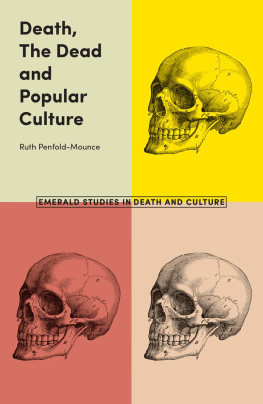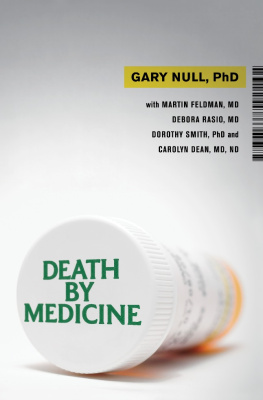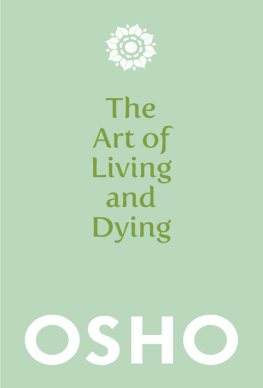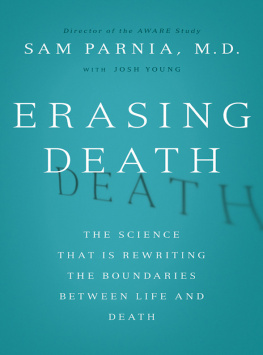Also by Dick Teresi
Lost Discoveries
Laser (with Jeff Hecht)
The God Particle (with Leon Lederman)
The 3-Pound Universe (with Judith Hooper)
Copyright 2012 by Dick Teresi
All rights reserved. Published in the United States by Pantheon Books, a division of Random House, Inc., New York, and in Canada by Random House of Canada Limited, Toronto.
Pantheon Books and colophon are registered trademarks of Random House, Inc.
Library of Congress Cataloging-in-Publication Data Teresi, Dick.
The undead : organ harvesting, the ice-water test, beating-heart cadavershow medicine is blurring the line between life and death / Dick Teresi.
p. cm.
eISBN: 978-0-307-90711-0
Title.
[DNLM: 1. Death. 2. Attitude to Death. 3. DeathAutobiography. 4. Persistent Vegetative State. 5. Tissue and Organ Harvesting. W 820] LC classification not assigned 610dc23 2011032025
www.pantheonbooks.com
Jacket photograph by Nicholas Eveleigh/Photodisc/Getty Images
Jacket design by Peter Mendelsund
v3.1
Contents
ONE
Death Is Here to Stay
TWO
A History of Death
THREE
The Brain-Death Revolution
FOUR
The New Undead
FIVE
Netherworlds
SIX
The Near-Death Experience
SEVEN
Postmodern Death
EIGHT
The Moment of Death and the Search for Self
Acknowledgments
Thanks to Judith Hooper and Janet MacFadyen for their extensive research, and to Shelley Wanger, Lynn Nesbit, Ken Schneider, and Juhea Kim for their efforts and support. Lynn Anderson provided deft copyediting.
Prologue
B POD of the intensive care unit (ICU) at Baystate Medical Center is very bright: intense lights, everything painted in primary colors. Cabinets, counters, and chairs are a sparkling blue, obviously intended to be cheery, not sepulchral. A blue central stripe on the grayish linoleum floor leads us from room to room. There are three ICU pods at this Springfield, Massachusetts, hospital, each with three rooms arranged like spokes around a central station filled with computer terminals. Doctors and nurses come and go.
The patients in their separate rooms, like sickly fish in glass tanks arranged for observation, are largely slack-mouthed and gray or pale yellow in color. Most are fitted with clear plastic tubes the diameter of vacuum-cleaner hoses attached to their mouths. Most are old and gnarled, with sallow, sickly complexions. Sometimes one can see a bare concave chest or a yellowed foot sticking out from beneath a sheet. None is conversing.
We are not here to see them. We have come for the star of B Pod. We will call her Fernanda, a fifty-seven-year-old woman of Portuguese descent, who looks as though she might have just come back from a day at the mall. Her dark olive skin appears healthy against the sheets. Her features do not show the ravages of suffering or pain. Her eyes are closed beneath the heavy arched eyebrows. She has thick black eyelashes. Her wiry black hair with strands of gray is arranged neatly on the pillow. She has delicate legs and exquisite feet. Her face is serene; her chest rises and falls with the familiar rhythm of normal human breathing. She looks as if she had been put to sleep by a wicked queen in a fairy tale and needs only to be reanimated. Her vital signs, displayed on a monitor in squiggles the bright green of coloring books, are normal. She looks better than I do.
We are all there, including a group of medical students and interns, to watch Dr. Thomas Higgins pronounce Fernanda brain dead. She had been at work when coworkers found her on the floor and threw water on her face, a tactic that doesnt work well against ischemic stroke. She probably had a brief headache, says Higgins, then fell unconscious. The ICU doctors at Baystate feel she will not recover. The brain-death team is about to make it official.
Those expecting space-age equipment, sophisticated brain scans, and the like, wont find it. The exam is conducted mostly with tools you could find around your home: a flashlight, a Q-tip, some ice water. Her reflexes are tested. A light is shined in her eyes. Her head is turned from side to side. Cold water is squirted into an ear. She is disconnected from her ventilator to make sure she cant breathe on her own. In less time than my ophthalmologist took to prescribe my last pair of bifocals, Fernanda is declared brain dead. That means she is legally dead, just as dead under the law as if her heart had stopped beating. Fernanda is then hooked back up to her ventilator to keep her organs fresh for transplant. Her heart continues to beat; her lungs continue to breathe. Though dead, she remains the best-looking patient in the ICU. The declaration of her death was more philosophical than physiological. A nurse says, Whatever it was that made her her isnt there anymore.
ONE
Death Is Here to Stay
For all the accomplishments of molecular biology, we still cant tell a live cat from a dead cat.
Lynn Margulis
ARE YOU dead or alive? A dumb question, it would seem. If youre reading this book, you are most likely alive. You know it, but do those in control know it? Will they acknowledge it? These are no longer stupid questions. The bar for being dead has been lowered. The bar for being considered alive has been raised. The old standards for lifeAre you breathing? Is your heart beating? Are your cells still intact, not putrifying?have been abandoned by the medical community in favor of a more demanding standard. Are you a person? Is what makes you you still intact? Can you prove it? Such concepts were previously the
This is a book about physical death. It began as a simple magazine article more than a decade ago, a report on the state of the art of death determination. I assumed I would find high-tech medical equipment and techniques that would tell us when a human being had stopped living, that would pinpoint the moment that what made her her was gone. I eventually abandoned this goal and the article itself. Humans have long lived in denial about their own deaths, but I discovered that this denial has spread to the medical establishment, even to our beliefs about who is dead and who is alive. Our technology has not illuminated death; it has only expanded the breadth of our ignorance. Technology indicates that many of our assumptions about life and death, consciousness and unconsciousness, are wrong. Technology is telling us a great deal about our ignorance, but we are ignoring the information. My focus is scientific information about physiological death, but science and cultural factors often compete in an unproductive manner, canceling each other out. Though we have made technological advances, they often remain unused when it comes to dealing with the dying and dead, so cultural factorsphilosophy, ethics, economics, religioncannot be ignored.
In the following chapters, you will meet brain-death experts, undertakers, cell biologists, coma specialists (and those who have recovered from coma), organ transplant surgeons and organ procurers, anesthesiologists who study pain in legally dead patients, doctors who have saved live patients from organ harvests, experimenters who have removed the hearts of dead people and restarted them many hours later, paramedics, doctors who have used brain-dead pregnant women as human incubators, pediatric neurologists who have kept the heart of a legally dead boy pumping for twenty years, nurses who care for beating-heart cadavers, ICU doctors who are now subtly pressured into declaring their patients dead rather than saving them, hospice workers, execution experts, veterinarians who put animals to sleep, Egyptologists specializing in mummies, doctors who communicate with those in coma and persistent vegetative state (PVS), people who have been frozen alive, doctors who take MRIs of cats while they kill them, doctors who have drained the blood from patients heads in the course of brain surgery, lawyers, historians of death, theologians, ethicists, and many others.









